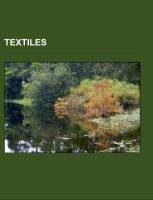
Textiles
Source: Wikipedia. Pages: 101. Chapters: African textiles, Alnage, Baldachin, Bamboo textiles, Basha (tarpaulin), Batting (material), Beetling, Biotextile, Bleachfield, Burnout (clothing), Calendering, Cellulose fiber, Colour fastness, Cosmetotextile, Decatising,... Viac o knihe
Produkt je dočasne nedostupný
24.46 €
bežná cena: 27.80 €
O knihe
Source: Wikipedia. Pages: 101. Chapters: African textiles, Alnage, Baldachin, Bamboo textiles, Basha (tarpaulin), Batting (material), Beetling, Biotextile, Bleachfield, Burnout (clothing), Calendering, Cellulose fiber, Colour fastness, Cosmetotextile, Decatising, Delustrant, Dermotextile, Desizing, Devoré, Dyeing, Eneas, Fabrikoid, Fish fur, Fly (tent), Fulling, Glossary of textile manufacturing, Glossary of textile terminology, Handle-o-Meter, Heatsetting, History of clothing and textiles, Hydroentanglement, Indienne, Irish linen, IWTO, Kiswah, Linenopolis, Linens, Linen tester, List of fabric names, List of textile fibres, Maori traditional textiles, Matelassé, Mercery, Meritas (cloth), Palepai, Sumatran ships cloth, Pidan (textile), Pile (textile), Pot-holder, Pua Kumbu, Singe, Snag (textiles), Stasilon, Stone washing, Straw plaiting, Tapis (Indonesian weaving style), Technical textile, Tenacity, Tenterground, Textile-reinforced materials, Textiles of Mexico, Textiles of Oaxaca, Textile bleaching, Textile Labelling Act (Germany), Textile manufacturing by pre-industrial methods, Textile preservation, Textile recycling, Texturizing, Ticking, Timeline of clothing and textiles technology, Tog (unit), Toran, Tulle bi telli, Units of textile measurement, Webbing, Woven fabric, Yarn. Excerpt: The manufacture of textiles is one of the oldest of human technologies. To make textiles, the first requirement is a source of fibre from which a yarn can be made, primarily by spinning. (Both fibre and fiber are used in this article.) The yarn is processed by knitting or weaving, which turns yarn into cloth. The machine used for weaving is the loom. For decoration, the process of colouring yarn or the finished material is dyeing. For more information of the various steps, see textile manufacturing. AbsorbencyA measure of how much amount of water a fabric can absorb.AcetateAcetate is a synthetic fiber.AcrylicAcrylic fiber is a synthetic polymer fiber that contains at least 85% acrylonitrile.Aida clothAida cloth is a coarse open-weave fabric traditionally used for cross-stitch.AlnageAlnage is the official supervision of the shape and quality of manufactured woolen cloth.AlpacaAlpaca is a name given to two distinct things: AngoraAngora refers to the hair of the Angora rabbit, or the fabric made from Angora rabbit fur. (Fabric made from angora goat is mohair.)AppliquéAppliqué is a sewing technique in which fabric shapes, lace or trim, are sewn onto a foundation fabric to create designs.AramidAramid fiber is a fire-resistant and strong synthetic fiber.ArgyleAn argyle pattern is one containing diamonds in a sort of diagonal checkerboard pattern. Backstrap loomBackstrap looms, as the name implies, are tied around the weaver's waist on one end and around a stationary object such as a tree, post, or door on the other. Tension can be adjusted simply by leaning back. Backstrap looms are very portable, since they can simply be rolled up and carried.BaizeBaize is a coarse woollen or cotton cloth, often coloured red or green.Ballistic nylonBallistic nylon is a thick, tough synthetic fabric used for a variety of applications.BaratheaBarathea is an indistinct twill or broken rib - usually a twilled hopsack weave - with a fine textured, slightly pebbled surface. Often of silk or si
- Vydavateľstvo: Books LLC, Reference Series
- Formát: Paperback
- Jazyk:
- ISBN: 9781156628546


 Anglický jazyk
Anglický jazyk 







 Nemecký jazyk
Nemecký jazyk 